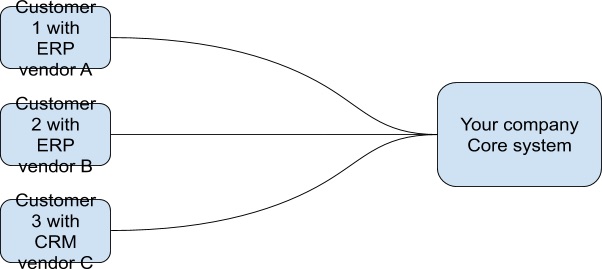Peter Kreslins
The concept of a developer portal is to provide the necessary technical information to configure and manage the communication between an API and both internal and external systems. Originally, it was not thought of as a business-generating tool for companies that adopt them. Rather, it was an interface between APIs, SDKs and other digital tools and their administrators.
However, over time, many developer portal elements have caused friction for partners and resulted in higher costs for the company providing the data through APIs.
An alternative option to replace a developer portal is a Hybrid Integration Platform (HIP), a simple system connection solution that has the potential to generate more business through pairing ecosystems directly, efficiently and at a lower cost.
Fixing potential developer portal problems
The leading cause of friction within a developer portal is the amount of time it takes to create and support it. Quite often, an integration is delayed because the company providing the API is stuck waiting for support from the people they are working with.
To fulfill the demand for consumers in different stages of maturity, companies providing APIs later realized they needed to provide more data, new business cases and different mappings and transformations.
Once the portal and APIs adapt to the system, three key factors are necessary to provide a good user experience in the developer portal:
- Complete and easy-to-use documentation.
- Actionable and effective solution options.
- Quick response time.
Frequently, isolated and disconnected business challenges complicate developer portal implementations. To avoid such challenges, you should address these questions before the implementation process takes place:
- How can you ensure the business will benefit from the connection with partners, suppliers and customers?
- Is it possible to become more efficient, have lower integration costs and improve implementation and adoption times for technological solutions?
- How is innovation unlocked when previously unavailable data and services are made internally available?
When approaching a systems integration, it’s essential to develop a solution that considers business results first, before simplifying or removing any technical issues. Fixing predicted issues before they become problems only wastes time and takes the focus off the goal of making your business more efficient and profitable. Yet, many times we see the opposite happen — businesses tend to spend too much time fixing problems before they even occur.
As the use of hybrid integration systems grows, it’s proving to drastically reduce adoption complications, improve the user experience and minimize technical complexity, while increasing security. As a result, many organizations are considering using an HIP when they need to connect systems.
Are open APIs effective enough to acquire partners and customers?
To answer this question, we must analyze the total cost to take the traditional approach of generating a developer portal. Here are some things to consider:
- Cost and labor to create educational material for the APIs’ business proposition and the effort to create technical material about the APIs.
- Procedures to make APIs with accessible test mechanisms.
- The process to make calls in the different available languages (some will not necessarily be used).
- Time to develop SDKs in different languages and maintain compatibility.
- Ability to support everything.
- Is there a need to hire an evangelist and business developer to support the real people behind the search for API-based solutions.
The investment to create a developer portal depends on whether the API evangelist and business developer can prove that the use case is worth the investment, despite the fact that the portal might not be used in the way it was initially intended.
For example, imagine a bank wants to create APIs to provide loans. The APIs must pass all the aforementioned steps to feed the developer portal and drive business.
Once all the documentation is produced, the APIs are set up and the test environment and other configurations are established, the bank needs to recruit developers and partner companies to create a solution for the APIs. Furthermore, the bank’s business developer must find customers to use the APIs.
Once a bank customer enrolls in the developer portal and explores the APIs, its documentation and code to build the integrations, they need to decipher how the APIs will connect with their internal systems such as ERP, CRM and EDI.
A hybrid integration platform (HIP) reduces the tension of adding partners
A hybrid integration platform (HIP) enables users to develop, secure and govern integration flows that connect diverse applications, systems, services and data stores. In addition, an HIP enables rapid API creation/composition and lifecycle management to meet the requirements of diverse integration use cases.
A modern HIP also offers a visual and intuitive interface based on low-code concepts, which replaces the integration complexity with ready-to-use components that implement business cases and reduce the effort to accomplish many integration tasks.
An HIP requires modern architecture to scale, covering and replacing the main features of traditional integration landscapes like message queues, service brokers, file management and more. It serves as an accelerator, so development teams can focus on what is most important to them: their business demands. With an HIP, you can create a point-to-point integration system with security and data integrity, while accelerating solutions development.

Accelerate time to market and make your business more effective while boosting revenue
There are many features that make an HIP a legitimate consideration when connecting numerous systems. In addition to increasing efficiencies and providing more visibility, an HIP offers:
- A connection with numerous market systems.
- Simple and fast data transformation.
- Reusable, standard documentation.
- End-to-end security integration.
- Real-time view of integration adoption by business stakeholders.
- Support and monitoring during the term of the contract with no limits.
- No additional costs to configure the integrations.
- Specialized best-in-class architectural practices.
One of the most advantageous benefits to an HIP is the reusable encapsulated business cases. That means, once you create a package, you’re able to reuse it for many other business situations. For example, if you supply loans for students, once you create the concept, logic and code of delivering the loan, that package can be reused by other education groups that use an ERP.
Additionally, you can offer these packages in marketplaces — not of APIs, but of business cases, to companies and partners that have a use case for them.
The packages also add traction to your organization, as your business developer can offer ready-to-use packages to other companies or partners in the marketplace.
API evangelists are in charge of promoting and supporting their use by partners. However, with the package approach, evangelists take on a new role, giving partners the opportunity to create new packages in real-time. For example, a developer can discuss separate business cases while creating packages directly in the HIP.
Partners with a sandbox testing environment are able to simulate and create packages to accelerate any kind of business. For instance, if a university wants to provide credit for students to pay tuition using a bank, and the university has an ERP, a
HIP provides the connection by using the package, the bank and ERP, providing logic and built-in security that has already been tested and approved.
While the goal of an HIP is not to eliminate the access point of APIs, it’s to provide a marketplace of ready-to-use business cases that help make businesses more efficient. Instead of one open API, an HIP brings a broader, end-to-end, view that considers the global ecosystem that requires systems integration in a standard, yet cumbersome, way.
Another benefit an HIP offers is it enables businesses to change the way they interact with partners, customers and revenue streams, while decreasing the disconnection between developers, APIs, architecture, integrations and potential deals.
Finally, an HIP aims to future-proof your organization’s structure to engage business ecosystems with cloud-scale, ready-to-use processes, business cases and security. The HIP approach can provide innovation opportunities not available with the current developer portal and API-based model.































Comment